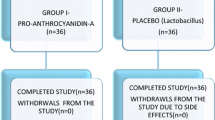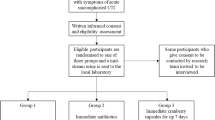Abstract
Purpose
Plants extracts are used in urology to manage urinary tract infections. We aimed to evaluate the efficacy of a preparation with solidago, orthosiphon, birch and cranberry extracts (CISTIMEV PLUS®) in reducing microbial colonization and biofilm development in patients with indwelling urinary catheters.
Methods
All consecutive outpatients attending our department between January and June 2010 for the substitution of indwelling catheters were considered for this single-blinded, randomized and controlled pilot study to test superiority of the preventative management (CISTIMEV PLUS®, 1 tablet daily for 30 days) in respect to no treatment. A sample size of 10–40 participants per group was considered adequate. All patients underwent urine culture the same day of the catheter substitution and were then randomized into test group (n = 48) and control group (n = 35). Ultrastructural analysis was also performed. After 30 days, the catheter was replaced and the analysis repeated. The primary outcome was the rate of positive urinary culture at the end of the entire study period.
Results
Ten patients abandoned the study. At 30 days, according to per-protocol analysis, the groups statistically differed regarding the rate of positive urine cultures: test group 10/43 and control group 16/30 (p = 0.013) (−30.1 % [95 % CI −51.94 to −8.21]). The most common isolated bacteria were Escherichia coli and Enterococcus faecalis.
Conclusions
The use of solidago, orthosiphon, birch and cranberry extracts resulted in a significant reduction of microbial colonization in patients with indwelling urinary catheters. Larger clinical trials are needed to demonstrate that the effects here reported are sufficient to reduce symptomatic catheter-associated urinary tract infections.




Similar content being viewed by others
References
Vergidis P, Patel R (2012) Novel approaches to the diagnosis, prevention, and treatment of medical device-associated infections. Infect Dis Clin North Am 26(1):173–186
Tenke P, Köves B, Nagy K et al (2012) Update on biofilm infections in the urinary tract. World J Urol 30(1):51–57
Matsukawa M, Kunishima Y, Takahashi S, Takeyama K, Tsukamoto T (2005) Bacterial colonization on intraluminal surface of urethral catheter. Urology 65(3):440–444
Tenke P, Kovacs B, Bjerklund Johansen TE, Matsumoto T, Tambyah PA, Naber KG (2008) European and Asian guidelines on management and prevention of catheter-associated urinary tract infections. Int J Antimicrob Agents 31(1):S68–S78
Klevens RM, Edwards JR, Richards CL Jr et al (2007) Estimating health care-associated infections and deaths in US hospitals, 2002. Public Health Rep 122(2):160–166
Pickard R, Lam T, Maclennan G et al (2012) Types of urethral catheter for reducing symptomatic urinary tract infections in hospitalised adults requiring short-term catheterisation: multicentre randomised controlled trial and economic evaluation of antimicrobial- and antiseptic-impregnated urethral catheters (the CATHETER trial). Health Technol Assess 16(47):1–197
Guay DR (2009) Cranberry and urinary tract infections. Drugs 69(7):775–807
Mathers MJ, von Rundstedt F, Brandt AS, König M, Lazica DA, Roth S (2009) Myth or truth. Cranberry juice for prophylaxis and treatment of recurrent urinary tract infection. Urol A 48(10):1203–5, 1207–9
Leuschner J (1995) Anti-inflammatory, spasmolytic and diuretic effects of a commercially available Solidago gigantean herb extract. Arzneim Forsch 45:165–168
Yarnell E (2002) Botanical medicines for the urinary tract. World J Urol 20(5):285–293
Ameer OZ, Salman IM, Asmawi MZ, Ibraheem ZO, Yam MF (2012) Orthosiphon stamineus: traditional uses, phytochemistry, pharmacology, and toxicology. J Med Food 15(8):678–690
Ghimire BK, Tamang JP, Yu CY, Jung SJ, Chung IM (2012) Antioxidant, antimicrobial activity and inhibition of α-glucosidase activity by Betula alnoides Buch. Bark extract and their relationship with polyphenolic compounds concentration. Immunopharmacol Immunotoxicol 34(5):824–831
Urbaniak GC, Plous S (2013) Research Randomizer (Version 4.0) [Computer software]. Retrieved on June 22, 2013, from http://www.randomizer.org/
Naber KG, Bergman B, Bishop MC et al (2001) EAU guidelines for the management of urinary and male genital tract infections. Urinary Tract Infection (UTI) Working Group of the Health Care Office (HCO) of the European Association of Urology (EAU). Eur Urol 40(5):576–588
Mazzoli S, Cai T, Rupealta V et al (2007) Interleukin 8 and anti-chlamydia trachomatis mucosal IgA as urogenital immunologic markers in patients with C. trachomatis prostatic infection. Eur Urol 51(5):1385–1393
Christensen GD, Simpson WA, Younger JJ, Baddour LM, Barrett FF, Melton DM, Beachey EH (1985) Adherence of coagulase negative staphylococci to plastic tissue culture plates: a quantitative model for the adherence of staphylococci to medical devices. J Clin Microbiol 22:996–1006
Fiamegos YC, Nanos CG, Vervoort J, Stalikas CD (2004) Analytical procedure for the in-phial derivatization-extraction of phenolic acids and flavonoids in methanolic and aqueous plant extracts followed by gas chromatography with mass-selective detection. J Chromatogr A 1041(1–12):11–18
Hertzog MA (2008) Considerations in determining sample size for pilot studies. Res Nurs Health 31(2):180–191
Schumm K, Lam TB (2008) Types of urethral catheters for management of short-term voiding problems in hospitalized adults: a short version Cochrane review. Neurourol Urodyn 27(8):738–746
Avorn J, Monane M, Gurwitz JH, Glynn RJ, Choodnovskiy I, Lipsitz LA (1994) Reduction of bacteriuria and pyuria after ingestion of cranberry juice. JAMA 271(10):751–754
Tao Y, Pinzón-Arango PA, Howell AB, Camesano TA (2011) Oral consumption of cranberry juice cocktail inhibits molecular-scale adhesion of clinical uropathogenic Escherichia coli. J Med Food 14(7–8):739–745
Laplante KL, Sarkisian SA, Woodmansee S, Rowley DC, Seeram NP (2012) Effects of cranberry extracts on growth and biofilm production of Escherichia coli and Staphylococcus species. Phytother Res. doi:10.1002/ptr.4592
Budzyńska A, Wieckowska-Szakiel M, Sadowska B, Kalemba D, Rózalska B (2011) Antibiofilm activity of selected plant essential oils and their major components. Pol J Microbiol 60(1):35–41
Di Martino P, Agniel R, David K et al (2006) Reduction of Escherichia coli adherence to uroepithelial bladder cells after consumption of cranberry juice: a double-blind randomized placebo-controlled cross-over trial. World J Urol 24(1):21–27
Hachem R, Reitzel R, Borne A et al (2009) Novel antiseptic urinary catheters for prevention of urinary tract infections: correlation of in vivo and in vitro test results. Antimicrob Agents Chemother 53(12):5145–5149
Pickard R, Lam T, MacLennan G et al (2012) Antimicrobial catheters for reduction of symptomatic urinary tract infection in adults requiring short-term catheterisation in hospital: a multicentre randomised controlled trial. Lancet 380(9857):1927–1935
Griffiths R, Fernandez R. (2005) Policies for the removal of short-term indwelling urethral catheters. Cochrane Database Syst Rev (1):CD004011
Acknowledgments
The authors wish to acknowledge FarmaceuticaMEV, Siena, Italy for providing CISTIMEV PLUS® used in the study. Special thanks to Professor John Denton for manuscript language revision and to all the members of the Santa Chiara Regional Hospital, Department of Urology, for assistance in sample collection.
Conflict of interest
All authors declare no financial/commercial conflicts of interest.
Author information
Authors and Affiliations
Corresponding author
Rights and permissions
About this article
Cite this article
Cai, T., Caola, I., Tessarolo, F. et al. Solidago, orthosiphon, birch and cranberry extracts can decrease microbial colonization and biofilm development in indwelling urinary catheter: a microbiologic and ultrastructural pilot study. World J Urol 32, 1007–1014 (2014). https://doi.org/10.1007/s00345-013-1173-5
Received:
Accepted:
Published:
Issue Date:
DOI: https://doi.org/10.1007/s00345-013-1173-5




